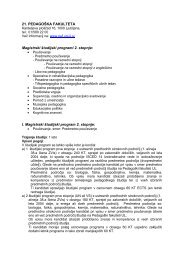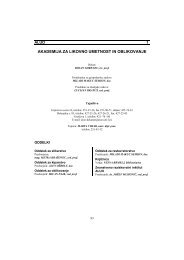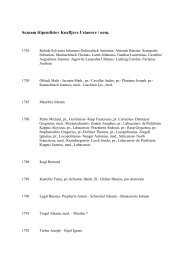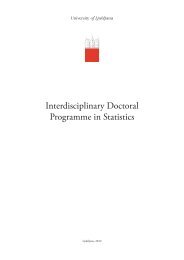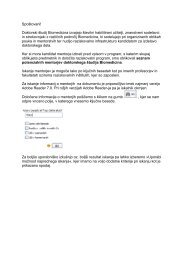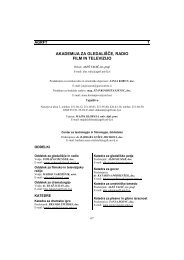Medicinska fakulteta Univerze v Ljubljani 1919–1945 - Univerza v ...
Medicinska fakulteta Univerze v Ljubljani 1919–1945 - Univerza v ...
Medicinska fakulteta Univerze v Ljubljani 1919–1945 - Univerza v ...
Create successful ePaper yourself
Turn your PDF publications into a flip-book with our unique Google optimized e-Paper software.
of National Health situated the newly founded hygiene institute<br />
and bacteriological station in the building� The Pathological<br />
Department and the anatomical and histological institute were<br />
left only with the basement, corridor and two rooms, one of which<br />
was reserved for the Pathological Department only� The corridor<br />
served as the office and workroom of the professor of anatomy<br />
and the assistant professor of histology, a workshop for their<br />
attendants and as a room for student microscope practicals� In<br />
the one room left there were lectures in general anatomy, nervous<br />
system anatomy and physiology, histology and physiology in the<br />
mornings, and in forensic medicine for lawyers on Saturdays�<br />
In the afternoon, dissection practicals were held in the same<br />
room� The Histological Institute was given two still unfinished<br />
rooms for practicals on the ground floor of the new Anatomical<br />
Institute� When the building was provisionally completed, the<br />
institute occupied the new premises� It was allotted two large<br />
rooms on the first floor and two smaller rooms with a separate<br />
entrance underneath the lecture hall, a storeroom and part of the<br />
corridor where an area for the laboratory assistant was arranged�<br />
The Physiological Institute got the ground floor, basement and<br />
halls on the second floor of the side wing� While the rooms were<br />
adapted to the institute, they did not fully meet its requirements�<br />
Most of all, the institute lacked large, light and dry rooms in the<br />
basement in which to keep its sensitive measuring instruments<br />
The animals were placed in the shed, an extension to the Pathological<br />
Department building, which, however, was also too small�<br />
The Anatomical Institute was allotted two level halls in the side<br />
wing, serving for dissection practicals, and a cellar for cadavers,<br />
with six rooms still available in the old building above the Pathological<br />
Department�<br />
When occupied, the Anatomical Institute building was only<br />
provisionally completed, poorly equipped due to the lack of<br />
funds and its large lecture hall remained unfinished until the<br />
end of the 30s� Conditions in the newly built facility were<br />
vividly described by Professor Seliškar� The final works on the<br />
Anatomical Institute drag on. Apparently three businesses have<br />
been ruined in the process. Still, they have certainly made great<br />
mistakes. An expert critic wrote that the building is the youthful<br />
sin of the architect who designed it. It really must be the oddest<br />
house of all the University’s buildings if not in all of Ljubljana.<br />
Along with anatomy and physiology, the Physiological Institute<br />
also moved in, just temporarily, of course - plans for a separate<br />
building were already in preparation. When moving in, the plans<br />
and agreements were not followed and changed all the time. For<br />
example, a large basement room was destined for physiological<br />
chemistry practicals with special installations, when anatomy<br />
suddenly claimed it for the storage of cadavers. After years of<br />
inadequate sewers it decayed and became useless. Eventually it was<br />
passed on to physiology. The large lecture hall was left unfinished<br />
for many years in crude condition... The institute has five storeys.<br />
122<br />
In none of these can the respective areas be fully allocated. The<br />
paths of institute staff cross all over the house, as do the paths<br />
of students... The specific activities of institutes are sometimes<br />
unpleasant to others. This causes much inconvenience. Our staff<br />
is disturbed by the smell of formalin spreading through the house<br />
from the anatomical rooms... we adjusted to the inadequacy of the<br />
building as well as the scattered rooms...<br />
The crisis was partly eased by a donation from Doctor Ivan<br />
Oražen, who bequeathed his houses in Wolfova Street and<br />
Dolenjska Road to the faculty and its students in 1921; they were<br />
converted into the Oražen Hall of Residence�<br />
A provisional extension to the surgical pavilion was built from<br />
1936 to 1940, consisting of two storeys� Its ground floor housed<br />
a surgical clinic with an operating room and X-ray room and<br />
the first floor an internal clinic� The next year, construction of a<br />
clinical lecture hall for both clinics began�<br />
Efforts to Preserve and Complete the Faculty<br />
of Medicine<br />
The joy at the establishment of the first Slovenian university was<br />
no smaller for the fact that its Faculty of Medicine comprised only<br />
the first two years, given the expectations of its gradual completion�<br />
The universities in Belgrade and Zagreb were managed according<br />
to their respective legislations, but the Ljubljana University was<br />
governed by the Belgrade University’s acts until a special act<br />
was passed, as specified by its establishment act� The promised<br />
special act for the Ljubljana University was never passed; a<br />
university act for the whole country began to be prepared in<br />
the early twenties, reflecting the Belgrade authorities’ aspiration<br />
for closer ties between all three Yugoslav universities, whereby<br />
respective sciences would be developed and expanded only at the<br />
universities best equipped for the purpose� The existence of the<br />
incomplete Ljubljana Faculty of Medicine was thus threatened<br />
every time the university or financial act was debated� In the face<br />
of constant threats it was firmly defended by professors, students,<br />
the professional and broader community and current faculty<br />
leadership� Prof� Alfred Šerko held the one-year dean’s office<br />
fourteen times until his death in 1938 and thus bore the brunt of<br />
responsibility for the fate of the incomplete Faculty of Medicine�<br />
Until 1940, this function was also performed four times by Prof�<br />
Evgen Kansky and three times by Prof� Janez Plečnik�<br />
The question of the justification and feasibility of developing<br />
all the Ljubljana University faculties first arose in the second<br />
academic year when the university act was being drawn up� At the<br />
beginning of the next academic year, Ljubljana received news of<br />
the medical and technical faculties being abolished� This intention



